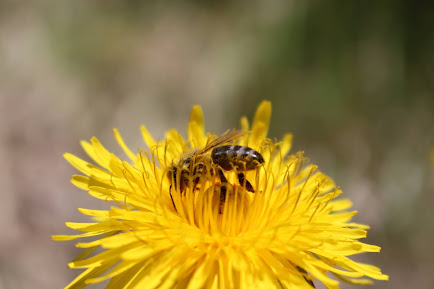This week’s blog post features some key tips and reminders
for buying bees…because what better thing to spend money on?! We couldn’t think
of anything either! Keep reading below for information on the different types
of honey bees and colonies available for purchase (i.e., nucs, packages and
entire hives), what is involved in buying bees, who to buy from and who NOT to
buy from, and registration requirements.
Valentine’s Day is coming up this Sunday and what sweeter
thing to talk about than honey! Like a good love, honey is sweet, natural, and
can help heal wounds. Honey has been used in wound care practices since ancient
times, thanks to its natural antimicrobial and anti-inflammatory properties. See
below to find out more about the healing powers of honey.
Tips and Reminders for Buying Bees
Buying bees is exciting but it is important to make sure
that the decisions you make throughout the purchasing process are well-informed
and will set you up for success. There are three main ways for beekeepers to
purchase bees: as nucleus colonies (‘nucs’), as packages, and as full colonies.
Each purchasing option has varying availability from season to season, and its
own set of pros and cons depending on the planned purpose of your future bees.
Comparing availability: nucs are typically available after blueberry pollination
from beekeepers from May to July; packages of bees are available before
blueberry pollination from suppliers around early April; and full colonies are
available throughout the year from beekeepers. Although these options are
typically ‘available’ at certain times of the year, it is important to
communicate with sellers well ahead of time to confirm availability and cost to
get your orders in and reserve your bees. When choosing an option for buying
bees, there are many considerations to keep in mind, including disease and pest
transfer, biosecurity, equipment requirements and cost. Here are 5 quick tips
from ATTTA to ensure the bees you are purchasing are healthy and disease free:
- Know the brood diseases and know what healthy brood should look like
- Check the inspection report; sellers MUST have this to be able to sell bees in Nova Scotia
- Make sure your apiary is ready for new bees (e.g., equipment, feed, space, etc.)
- Shadow an experienced beekeeper to gain insight on region specific management practices
- Keep good records to track successes and make sure you are supporting colony health
For a comprehensive breakdown of the pros and
cons associated with each purchasing option, and more tips on choosing a seller
and purchasing bees, check out ATTTA’s Spring Honey Bee Management Guide.
After
you’ve purchased your bees, the next step is to make sure you are properly
registered as a beekeeper according to your provincial beekeeping regulations. Registration
requirements and beekeeping regulations vary from province to province, so it
is important to make sure you are following the regulations specific to the
province where you are keeping bees. Please refer to provincial websites for
more information on registration requirements. Also, please note that importing
bees from outside of your province requires additional application and approval
processes not covered in this post.
There is currently no beekeeper registration requirement in the province of PEI
Bee...my honey, you are now my first love - A whimsical review*
In this recent publication by surgeon and wound care expert, Amit Kumar C Jain, medical and symbolic applications of honey throughout history are explained and extend to reason how, to this day, honey remains a medically advantageous prescription for the treatment of many wounds. Honey has a long record of being used for various applications since ancient times and is considered to be the nectar of gods. In ancient Egypt, Greece, and Rome, honey was a common treatment for wounds and intestinal issues. The exact composition of honey varies depending on the source, but generally is made up of water, sugars (especially fructose and glucose), proteins, vitamins (e.g., vitamin B complexes and vitamin C), and minerals (e.g., Zinc, Calcium, etc.). Honey is an acidic substance with pH between 3.4 and 6.1, however, the level of acidity varies depending on the composition. Honey's acidity and hygroscopic effect, thanks to its high sugar content, work together to offer the antimicrobial properties of honey that are being implemented in modern day medical wound care treatments. Honey inhibits growth of approximately 60 species of bacteria and is known to sterilize wounds in 7-10 days from the initial treatment. This honey used for medical purposes has undergone gamma irradiation, which sterilizes the honey without affecting its physicochemical properties, and labels it as 'medical grade'. In studies comparing the antimicrobial properties of honey to other antimicrobial agents, honey was found to be the superior treatment option and has been observed to be the more effective option in the treatment of stubborn biofilms and non-healing wounds. Beyond its antimicrobial properties, honey is also known to have good anti-inflammatory properties. Dr. Amit Kumar C Jain concludes his thoughts on the medical uses of honey with the statement, "With many benefits of this god's nectar, there is no doubt that honey is my first love in wound care with other wound care products being second choice, especially when there is multi-resistant bacterial infection in biofilms." *
Connecting with ATTTA Specialists
If you’d like to connect with ATTTA specialists or learn more about our program, you can:

